It’s a little ironic that one of the smallest rooms in the house–the bathroom–can be the biggest exercise in restoration frustration, especially when it comes to the tiles. Because bathrooms are in constant use it’s common to see damaged tiles and mismatched replacement jobs underfoot. Additionally, plumbing upgrades through the years can leave gaping holes around pipes—under the lavatory, for example.
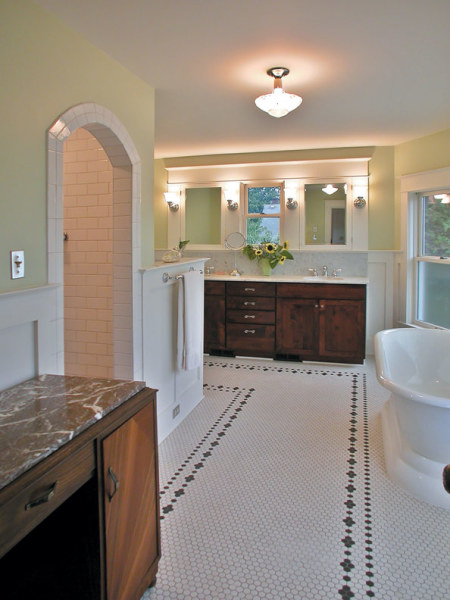
A hex tile floor patterned with a simple flower-and-dot border is a timely restoration choice for this 1912 Foursquare in Portland, Oregon, as is the separate shower stall of subway tiles with razor-thin grout.
Arciform
Just a decade ago, finding matching tile to fill in these gaps was like looking for a needle in a haystack. Today it’s much easier, thanks to the Internet and a growing number of companies offering historically designed products. So, say you need to replace a few tiles or install an entire floor, where do you begin? A little background on what to look for, as well as some nifty tricks for making do with what you find, can help you smoothly connect the old tile with the new.
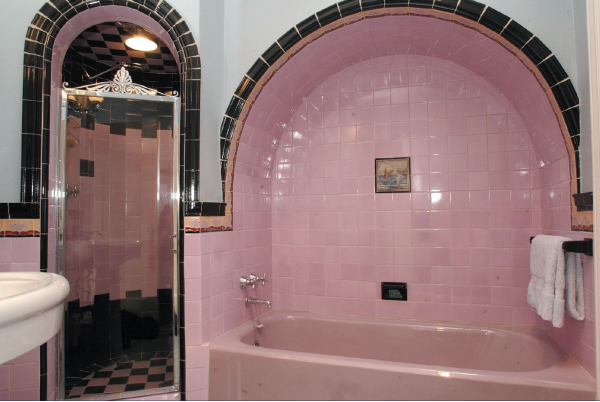
Look to original installations for inspiration; 1930 baths often mixed up colors on trim and floors for impact, and even field tiles could vary slightly in hue.
San Fransisco Chronicle
It’s Hip to be Square
Ever notice how crisp those 1910s tiled walls appear, with narrow grout lines as perfectly straight and spaced as soldiers standing at attention? That’s because they were manufactured with square edges designed to be laid in close, tight courses by craftsmen who took the time to lay tiles meticulously. Today everyone is in a hurry, so manufacturers have responded with products designed to speed up the setting process. You can buy tiles with pillowed edges that downplay grout lines, and tiles with crooked, irregular edges that disguise places where tiles aren’t perfectly aligned. If you want an authentic look, though, square edges and a flat surface are important considerations for any tile you choose—be it 3″ x 6″ subway tile to complement an older bathroom, or 4″ squares to fit a bathroom from 1930 or beyond.
For square-edged subway tiles in a range of colors, look to reproduction specialists like Iron Gate Tile, Subway Tile, Designs in Tile, L’Esperance Tile Works, and Subway Ceramics. More mainstream manufacturers offer them, too. American Olean’s go by the name Greenwich Village, and Daltile’s are called Rittenhouse Square. New York’s Nemo Tile is another good resource for subway tile. If 4″ x 4″ field tiles are what you’re after, Daltile alone offers them in 32 colors including cobalt blue, aubergine, and 1950s (and ’20s) Pepto-Bismol pink. Looking to match tiles manufactured between the 1880s and the 1920s? Designs in Tile’s Selene Seltzer claims they’ve been able to match 90 percent of the tiles brought to us through the years, although the company is currently booked into 2008. Of course, the dozens of architectural salvage companies accessible on the Internet can sometimes have exactly what you’re looking for, too.
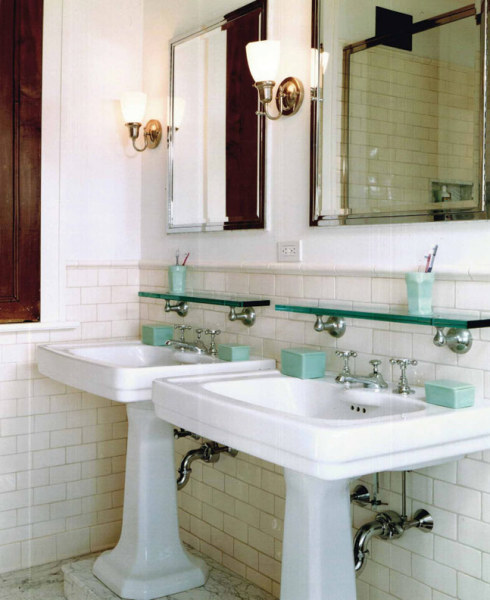
Subway tiles topped with round cap molding forge a crisp-looking bath.
L'Esperance Tile Works
Suppose you’re lucky enough to find tile in a matching shade but the wrong size. You can cut it down yourself with the help of a quality continuous wet-saw with a diamond blade. If you need to resize a large quantity of tile, sometimes a tile dealer will make the cuts for you. It never hurts to ask.
One of the most important characteristics of period bathrooms is razor thin grout, and installing it has gotten easier recently thanks to today’s ultra-modern flooring trend. The popularity of laying oversized marble and granite floor tiles with barely visible seams has made 1/16″ plastic tile spacers readily available. Coincidentally, this is the size needed to reproduce the striking grout spacing common a century ago.
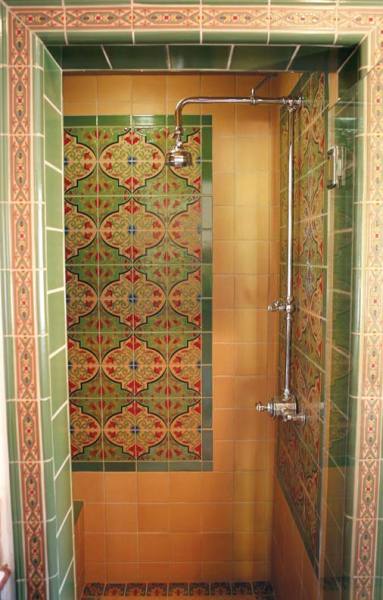
Inset tile panels featuring floral designs in complementary colors became popular in the 1930s, and can be a good solution when matching tile is impossible.
California Pottery & Tile Works
The Color Connection
Generally, old bathrooms came in two color palettes: all white, and screaming Technicolor. If your house predates 1927, you can’t go wrong with pure white. It’s important to remember, though, that even white comes in different shades. Always lay potential new tiles beside old examples, and compare the two at different times of day. Just as paint colors shift with the moving sunlight, the appearance of tiles can, too.
With colored tiles, even original batches from the same manufacturer could vary. This is obvious in many photographs of 1930s bathrooms, where the color seems more intense on some tiles than on others. Take advantage of this variation when tiling large spaces, and mix up two or three closely matching shades; this not only mimics a historic look, it’s also more forgiving for repairs that pop up down the road. The most important thing to remember when matching tile is to buy lots of it, stashing away extras for a rainy day repair or, heaven forbid, a broken pipe.
Of course, many wacky color combinations were popular from 1930 on; black with pastel pink or yellow, and varying degrees of Nile green to name just a few. When redoing a bathroom from scratch, research your options well. Several authoritative books exist on the subject, including Bungalow Bathrooms by Linda Svendsen and Jane Powell.
Sometimes, it’s okay to be interpretive. Some memorable tile installations in 1930s houses feature a dozen colors, ranging from deep jewel tones to creamy pastels, arranged in a kaleidoscope pattern across the wall. Imagination can be your friend when trying to patch a hole, too. If you’ve had no luck matching field tile, consider a tile panel, installed for visual effect, like those popular in the 1930s.
A Chip in Time
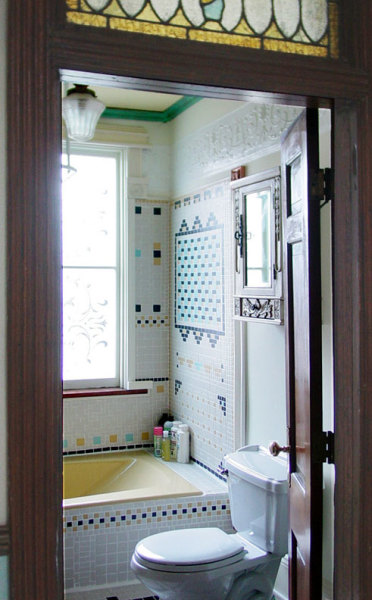
Mosaics can even be used to pattern walls, as in this interpretive restoration that integrates 19th-century motifs with a 1970s-era tub that proved impossible to remove.
Hebell, LLC
Speaking of visual effects, it’s often possible to hide small wear spots and chips with a patch. If a glazed tile is chipped in a place that won’t get wet or walked on, try this tip from restoration expert Cheryl Campbell of Hebell LLC. Cover the chip with model airplane paint followed by a coat of clear epoxy. The combination holds up well, and mimics the sheen on glossy tiles.
For working surfaces like floors that will be walked on, the National Park Service recommends patches of epoxy mixed with colored enamel, or tinted mortar that blends with the tile. Preservation Brief 40 also suggests leaving cracked and slightly damaged tile in place whenever possible, but recognizes that it’s sometimes necessary to remove and replace them. When this is the case, remember that old grout effectively joins the tiles together as one piece. You must therefore be exceedingly careful when trying to remove tiles—simply taking hammer and chisel to the damaged piece will shock the adjacent field with catastrophic results. You must first separate the damaged tile from the tile bed. Take a small hand-held angle grinder with a diamond blade and score the perimeter of the tile inside each edge, then cut an X into the middle. You should then be able to carefully chisel out the tile.
Getting Floored
The most obvious tile patterns for floors in older bathrooms are porcelain hex tiles, those little six-sided wonders now available on pre-webbed sheets in about a dozen colors from many companies. Subway Tile even sells them in three sizes—1″, 1 1/2″, and 2″. Small hex tiles were popular 100 years ago set in mosaic patterns from simple random flowers or dots to complex borders with crosses and Grecian keys. If a simple pattern is what you seek, you can recreate it by removing a few tiles from a pre-webbed sheet and replacing them with colored tiles. It’s possible to use this technique for more complex patterns as well, if you’re willing to invest the time. Today, there are even hex tiles available in marble, another historically appropriate material, from Ann Sacks. For the green-minded restorer who’s not a stickler for historic accuracy, Oceanside makes them in recycled glass.
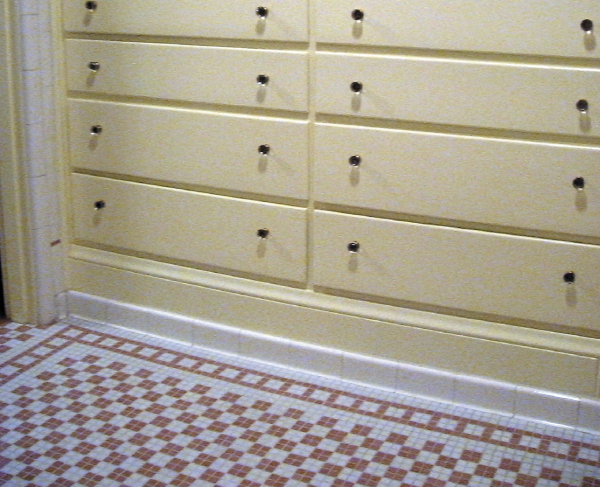
Modern mosaic tiles make creating period-appropriate floors a snap.
Courtesy of Arciform
Small rectangular, square, or pennyround tiles can be found to lay in a variety of elaborate mosaic patterns like pinwheels, spirals, and basket weaves. Both American Olean and American Restoration Tile have nifty websites that let you explore a range of antique patterns they can customize, on webbed sheets for ease of installation. For a nice, circa-1900 look, Anne De Wolf of the restoration company Arciform suggests laying a solid, colored border of 1 square tiles to frame an inset field of white hex tiles patterned with random dots or flowers.
Winning Trim
Finding trim pieces to complete a period bathroom used to be the toughest job of all, because for years none of the specialized tiles so common 100 years ago were readily available. Fortunately, this is no longer true. You can now purchase bullnose tiles (sometimes called surface caps) in at least a dozen colors, as well as corner bullnose, with two round-finished edges, and stack-on cove base tiles that flare at the bottom where the wall meets the floor. Decorative cap moldings have also become easier to locate in a variety of designs, including square, round, and P-shaped. Many intricate corner details of old are still hard to find, like inside and outside corners, but several companies do make them in white, which is why it’s good to remember that you can recreate a 1930s-era look by trimming a colored field tile with a white border at top and bottom.
The key with trim pieces, as with all the other tiling options, is to research the field of offerings carefully, then make selections best suited to your old-house needs. Even if they don’t end up being the perfect match, they often come close enough to create a seamless, winning restoration.







